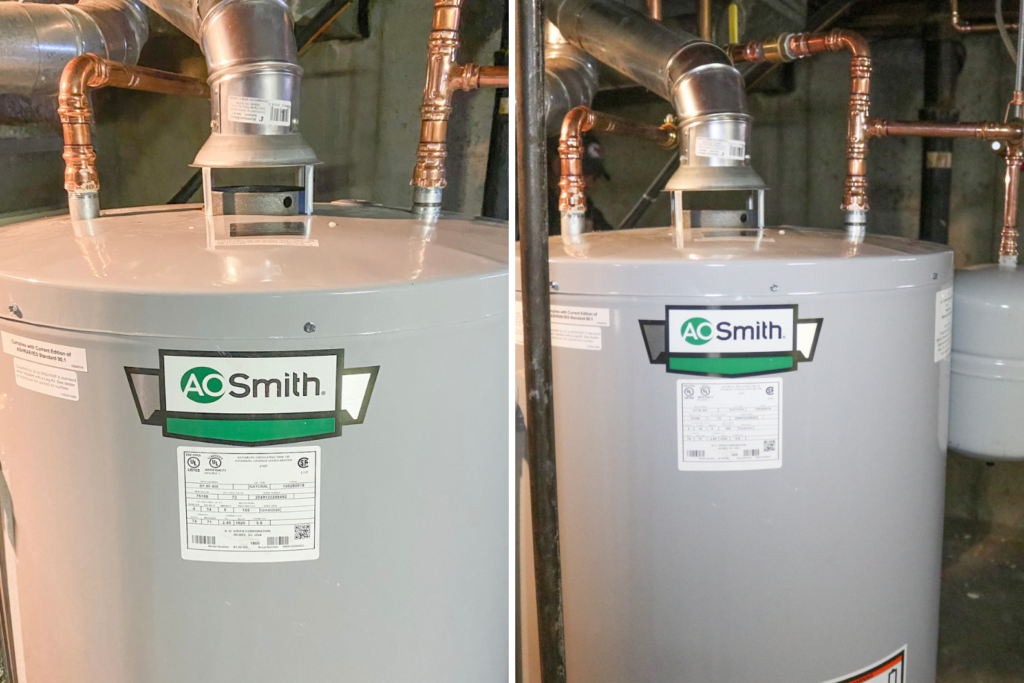How well do you know your water heater? Unsurprisingly, water heaters are an important piece of any plumbing system, no matter if that’s commercial or residential. As such, there’s no denying that it’s something you always want working efficiently. Unfortunately, for many homeowners, it is easy to forget about the water heater in your basement until you hop in the shower one morning and there’s no hot water.
If you’ve followed along on some of our prior blogs or on social media, chances are you’ve seen plenty of water heater content. Whether that be tips on maintaining them or pics/videos from water heater installations, it definitely is a popular plumbing component. On this week’s blog, we’re going to walk through a more in-depth look at the water heater. We’ll discuss a few of the various components and cover why they’re so important to the overall operation. Having said all of that, let’s hop right in and talk about water heaters.
For the purpose of this blog, we’ll be primarily analyzing the tank-style water heaters. If you’re interested in learning more about tankless water heaters, you’re more than welcome to check out one of our prior blogs HERE. Additionally, if you’d like to get a free quote for installing or repairing any type of water heater, fill out the form HERE.
Tank
First and foremost, with a water heater, you have the tank itself. As you could likely guess, the tank part of a water heater is where the water is stored. Simple enough, right? Well, while that statement is certainly true, the inside of the tank is a little more complex. If you’re interested in learning more about the inner workings of a water heater tank, I’ll include a couple of resources here:
AO Smith – Inside Electric Water Heaters
AO Smith – Inside Gas Water Heaters
In both of the links above from AO Smith’s website, you’ll notice there is foam insulation and a glass lining. Each of these features is designed to not only help keep the water heater operating at an optimal condition, but also ensure you’re protecting the tank from interior corrosion. The insulation is designed to keep the heat in the tank, while the glass lining is intended to serve as protection.
Expansion Tank
Take a look at the water heater inside your home. Do you see another smaller tank above it, connected by a pipe? This is what we call an expansion tank. We actually provided an in-depth explanation of expansion tanks in a past blog linked HERE. However, for the sake of this blog, I’ll provide a general overview of its purpose. To start, when water inside a tank is heated, it expands (also known as thermal expansion). Essentially, an expansion tank is there to take on this extra volume, so the main tank doesn’t have to.
For instance, look at a typical 40-gallon tank water heater. When heated to the desired temperature, it may expand by roughly half a gallon. If this additional half-gallon has nowhere to go, the pressure may fall on the actual tank. This extra pressure will just lead to more wear and tear, as well as likely leading to the heater deteriorating quicker than expected. As a side note, in the blog linked above about expansion tanks, we also covered sizing expansion tanks, signs of a failing expansion tank and the difference between open and closed systems.
T&P Relief Valve
Also known as the temperature and pressure relief valve, this next component that we’ll discuss is something that you’ll find on all water heaters. It is responsible for relieving any excess temperature or pressure, just as its name suggests. If the pressure or temperature were to get too high, the T&P Relief Valve would open, allowing that extra water to drain out through the overflow pipe. While it may sound like a myth, water heaters can actually explode and too much pressure is a perfect example of this. Long story short, make sure your T&P Relief Valve is always operating correctly and if you suspect there may be an issue, it wouldn’t hurt to have an experienced plumber get eyes on it.
Flue Pipe
Next on our list is the flue pipe. This is the silver pipe that comes down on the center of the top of the tank. It serves as the water heater’s venting system and is tasked with the job of taking away the exhaust gases to the outdoors. Keep in mind that it’s not uncommon either for these to be eventually tied into a larger vent duct. All in all, it’s another important piece to keeping your home safe. As a side note, electric water heaters do not require this venting.
Thermostat
Have you ever changed the temperature settings on your water heater? If so, you may be familiar with the thermostat. A thermostat allows you to set how hot you want the water in your water heater. If you do some research online, you may find there to be some slight variances in terms of what the preferred water heater temperatures are. In essence though, the range you should be considering is from 120-140 degrees Fahrenheit. Water below this range increases the susceptibility of bacteria developing. Water above this range raises concerns for scalding. It’s safe to say every household may have slightly different preferences, so feel free to play around with it and try to find something that meets your expectations. Some factors to take into account include if there are any young children in the household, if there’s anyone who is immunocompromised, or even the impact it has on your utility bills.
Elements
The final component that we’ll touch on today is something that’s actually only found in electric water heaters and that is the heating elements. As seen in the link above from AO Smith, you’ll typically have upper and lower heating elements. They are responsible for transferring the heat to the water. On the other hand, with gas water heaters, you have a burner to transfer the heat.
Need Water Heater Help in the Kansas City Area?
While we certainly weren’t able to cover every single piece of a hot water heater, we tried to cover some of the more prevalent ones. As you likely know, water heaters are an important part of our daily lives. It’s easy to assume that your water heater is always going to be working correctly, until one day you wake up and it’s not. And while water heaters may seem rather simple, I hope this blog post helped shed some light on a few of the various components that make up a heater. A deficiency in just one of these many components can easily result in issues for the entire system.
If you’re interested in getting a free quote on either a new water heater installation or a repair to an existing unit, our team at Stine-Nichols Plumbing would be happy to help. Our trained and licensed technicians have years of experience working with water heaters, no matter what the type or brand may be. To receive a free quote, you’re more than welcome to either call us directly at (816) 348-3481 or fill out the form HERE. We currently serve the entire Kansas City area, as well as all of the surrounding cities. We look forward to hearing from you.


